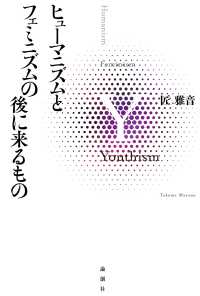- ホーム
- > 洋書
- > 英文書
- > Philosophy
基本説明
Analyzes common situations in contexts such as the family, school, religion, medical and funerary traditions to detect the aesthetic the aesthetic strategies by which these practices acquire significance.
Full Description
Katya Mandoki advances in this book the thesis that it is not only possible but crucial to open up the field of aesthetics (traditionally confined to the study of art and beauty) toward the richness and complexity of everyday life. She argues that in every process of communication, whether face to face or through the media, fashion, and political propaganda, there is always an excess beyond the informative and functional value of a message. This excess is the aesthetic. Following Huizinga's view of play as an ingredient of any social environment, Mandoki explores how various cultural practices are in fact forms of playing since, for the author, aesthetics and play are Siamese twins. One of the unique contributions of this book is the elaboration and application of a semiotic model for the simultaneous analysis of social interactions in the four registers, namely visual, auditory, verbal and body language, to detect the aesthetic strategies deployed in specific situations. She argues that since the presentation of the self is targeted towards participants' sensibilities, aesthetics plays a key role in these modes of exchange. Consequently, the author updates important debates in this field to clear the way for a socio-aesthetic inquiry through contexts such as the family, school, medical, artistic or religious traditions from which social identities emerge.
Contents
Part 1 The Labyrinths of Aesthetics; Chapter 1 The Problems of Aesthetics; Chapter 2 The Fetishes of Aesthetics; Chapter 3 The Myths of Aesthetics; Chapter 4 The Fears of Aesthetics; Part 2 On Aesthesis; Chapter 5 Demarcating Aesthetics; Chapter 6 Basic Categories for Aesthetic Analysis; Chapter 7 Conditions of Possibility of Aesthesis: The A Priori; Chapter 8 The Phenomenology of Aesthesis: Aesthetic Latching-On and Latched-By; Part 3 Towards Prosaics; Chapter 9 Prosaics and Poetics; Chapter 10 The Tangents of Prosaics; Chapter 11 The Nutrients of Prosaics; Chapter 12 The Play of Culture; Chapter 13 The Horizons of Prosaics; Part 4 Semio-Aesthetics; Chapter 14 Thresholds of Semiotic Perception: Sensation, Discernment and Regard; Chapter 15 The Axis of the Signic; Chapter 16 The Axis of the Symbolic; Chapter 17 Comparative View of Both Axes: The Symbolic and the Signic; Chapter 18 The Non-Axis of the Obtuse; Chapter 19 Beyond Semiosis to Aesthesis; Chapter 20 Aesthetic Enunciation and its Dialogical Character; Part 5 Octadic Model for Aesthetic Analysis; Chapter 21 Rhetoric and its Registers; Chapter 22 Dramatics and its Modalities; Chapter 23 The Rhetoric-Dramatic Coupling; Chapter 24 Con-Formations of the Rhetoric-Dramatic Coupling; Part 6 Matrixes and Identities; Chapter 25 The Matrixes: A General Approach; Chapter 26 Diachronic and Synchronic Perspective of Cultural Matrixes; Chapter 27 The Family Matrix; Chapter 28 The Religion Matrix; Chapter 29 The School Matrix; Chapter 30 The Medical Matrix; Chapter 31 The Occultist Matrix; Chapter 32 The Arts Matrix; conclusion Conclusions Matricial Symbols and Aesthetic Games;







